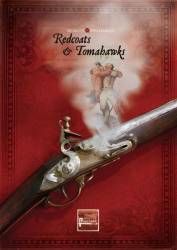
Following up my earlier write up on the new Muskets and Tomahawks version 2 rules, it is time to take a look at the first period supplement for the rules. Namely, Redcoats and Tomahawks, This supplement covers the fighting in North America from the French and Indian War all the way through the War of 1812.

Unlike the core rule book, the supplement comes to us in soft cover form. This is a bit of a surprise, considering all SAGA supplements are hard cover. I think I would have preferred hardcover, but I can appreciate having the supplements cost less.

With the new rules, the period sections are now separate books. It looks like Studio Tomahawk will be creating multiple books over time under these rules. The old M&T covered the French and Indian War and the American Revolution. The new Redcoats and Tomahawks not only covers those two conflicts, but adds the War of 1812 (you can of coarse also fight some of the Indian rebellions in between). Considering the listings, it would not be a stretch to play games for any of the early eastern Indian Wars in North America well into the 19th century (the Seminole Wars).

Rules
The supplement covers the armies of Britain, the United States, France and the various eastern Indian tribes. Each force is divided into commanders and unit types. As the listings cover multiple periods, each is keyed to show which units fought in which wars (e.g. British Infantry is available in all wars, but German Jagers are only available in the War of Independence). Each listing is pretty comprehensive, with many different unit types to choose from. Most units also have upgrades (in some cases downgrades) that can added to the units to give more variation. These include things like weapon options and specific traits. I would not have minded to see the often forgotten about Spanish in the new book, but they are rather obscure and can be represented using the French listings in a pinch!

Each unit and commander has a basic stat line and options, that is very much the same as the old rules. The only difference is that the new stats are aligned to the new D10 system. This means there are more variations that the old rules. It also means that you will not find some of the extreme differences, as stats tend to fall in the middle of th D10 range. This means that Militia is no longer totally worthless! Each unit entry has points costs listed. These are supplemented by unit upgrade points costs. This makes it vary easy for players to design their forces within a points cap, as desired.

The supplement also contains some background on the three conflicts covered and plenty of fluff and eye candy to keep the average gamer happy. More importantly, you will find the period specific missions and scenarios listed. This includes a random scenario generator, which is influenced by the type of troops the players field. The scenarios show set up/entry points, scenario special rules and primary victory conditions. These follow the new system in the core rule book. As before, each side has their own victory conditions, based on “their” mission. With the new system of using specific points on the map (chosen by the players), the combinations should ensure no two games feel the same.

Finally, the supplement contains a random event chart for the period. This is not unlike the old version of the rules. There are a few less options than before, but the events occurrence are not as common either. This rounds out the book quite nicely.

Summary
Redcoats and Tomahawks is a necessary purchase if you want to play games for the period from the French and Indian Wars to the War of 1812. The additional conflict was probably necessary to justify having the separate book and is a welcome addition. The print quality is excellent (even if it in not in my preferred hard cover). The entries are well laid out and clear. The new scenarios are improved versions of the old rules. All in all, a very nice supplement that should make most people vary happy!

- Manteuffel
